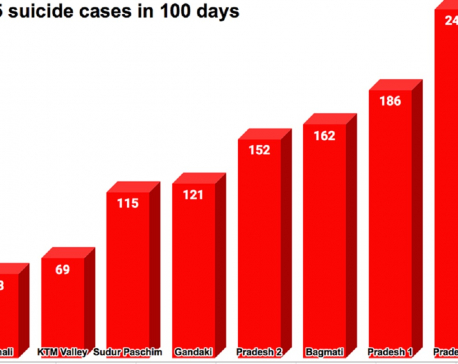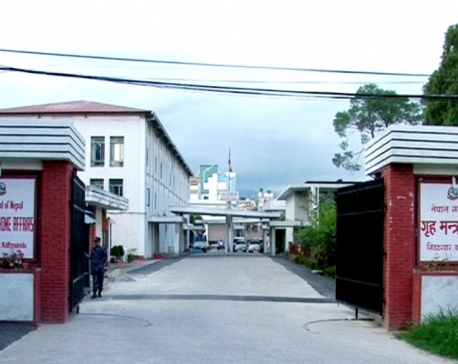
OR
Nepal Police in federalism
Published On: April 19, 2020 03:03 PM NPT By: Shreya Paudel and Samar SB Rana

More from Author
Political interference, bureaucratic meddling, and favoritism inside the police organization have perverted leadership succession and affected organizational integrity
Governments the world over are struggling to manage the COVID-19 pandemic, most using stringent measures such as the enforcement of lockdowns and shelter-in-place as their first resort. As such, maintaining public safety, enforcing lockdowns, and assisting health providers during such crises is a responsibility almost automatically and immediately shouldered by law enforcement agencies. It is therefore pertinent to soberly consider government policy towards the preparation of such agencies to respond effectively, which implies establishment and strengthening of appropriate legal/regulatory frameworks, strategic leadership capacity, and intergovernmental coordination ahead of crises.
Historically, policymaking in Nepal has often overlooked national interest, functional competence and evidence, and has instead veered between narrow group interest and adhocism. For Nepal’s security sector this attitude towards policymaking has had grave consequences, both near and long term, which will continue if left unaddressed. The most recent example of this is a much-publicized disagreement between the Nepal Police and the Ministry of Home Affairs (MoHA) on the adjustment of the police force through the reduction of personnel and specific reduction of Deputy Inspectors General (DIG). The disagreement is symptomatic of the rift between the police and government officials caused by a set of longstanding problems that have continually eroded the effective and efficient functioning of Nepal Police.
Case of police
Although quite recent, the disagreement reveals past problems of exclusion of police leadership from decision making regarding police administration by government officials who often have limited expertise in security matters. Especially when historically there has been a gap in understanding of law enforcement functions and of police culture among government officials, inclusive discussions can be helpful in building trust and cooperation. In this instance, a unilateral proposal by MoHA to reduce police personnel resulted in a standoff between police leadership and the ministry. In a transitional governance context wherein law enforcement functions and needs for provinces are yet to be rationalized, the MoHA proposal appears premature and arbitrary from a technical perspective. To the credit of the current MoHA leadership, there has been an openness since the recent outcry to accommodate police concerns.
From a political standpoint, the move to reduce the number of DIGs can be viewed as an attempt to hollow out and weaken Nepal Police leadership in decision making about devolved law enforcement across the country. In that light, it is worth asking why such force reductions have not been proposed for other government organizations that are not mandated to devolve under federalism.
Institutionalization of federalism in Nepal as per constitutional provisions mandates the restructuring of Nepal Police from a centralized organization to seven new Provincial Police organizations. Devolution of power for Nepal Police translates into the devolution of power to enforce and maintain the rule of law in sub-national governments throughout the country. Federalization is intended to move the police away from the rigid top-down hierarchy of a centralized agency that had to respond to the interests of a specific political and identity group. As is the case with security sector reform in most countries recovering from conflict, federalization of the Nepal Police is expected to ease regional, cultural, center-periphery tensions, and thus bring about stability and promote national unity in an inclusive and representational manner.
Further, the devolution of the policy also aims to protect the police from being misused as a tool or weapon of coercion. While this was the rationale behind the decision to federalize Nepal Police, it must also be noted that federal restructuring alone cannot ensure these factors. There is also a need for a political environment that enables intergovernmental cooperation, transparent decision making, and public accountability in formulating strategies, policies, and plans for a smooth transition to a federal structure.
Almost five years since the adoption of the constitution in 2015, there remains uncertainty and apprehension regarding this transition among the rank and file of Nepal Police. In large part, this is due to the lack of political will—both within the Nepal Police as well as in the MoHA—for needs-based strategic planning. The likely disruption to career trajectories of police personnel as a result of poor transitional planning has already had a demoralizing effect. Combined with working conditions and wages that are poor in comparison to other security sector agencies and a growing number of resignations, the reduction of officers in leadership positions adds further organizational instability, resentment, and deepening of chaos in this crucial public service.
The Constitution of Nepal 2015 enjoins the Government of Nepal to make necessary provisions for the delivery of services at the provincial and local levels, and in doing so adjust the employees serving in the government services at the time of promulgation of the constitution if required (Article 302). While adjustment of the civil service to support the government at the provincial and local levels has been concluded, albeit, with considerable controversy and delay, similar adjustment of police personnel to support provincial police organizations (per Article 268 and Article 302) remains to be completed. Furthermore, this adjustment is to be implemented using the existing resources and manpower of the Nepal Police. Issue of restructuring
In June 2016, a task force was established by the previous government to provide recommendations for restructuring Nepal Police in a federal setup. The task force prepared its report after thorough discussions with Nepal Police, former ministers, and secretaries, officials of foreign missions in Kathmandu and Nepali experts. The report was submitted and briefed to three successive home ministers. Implementation of some of the recommendations was commenced in 2017, most notably the appointment of special class officers, ie Additional Inspector Generals (AIGs) to head newly created provincial police organizations and the drafting of federal police legislation. However, these initiatives were halted in 2018.
On the face of it, the creation of an additional organizational layer for police at the provincial-level suggests a logical need to add to the number of personnel in the force. More fundamentally, however, the final number ought to be based on the rationalized distribution of discrete and shared functions between federal and provincial police organizations. Nonetheless, the establishment of provincial police organizations requires well-planned guidelines and deployment of suitable personnel to support the managerial and operational functions of the police.
Except for the 2016 task force report, such guidelines have neither been discussed nor decided since. Instead, adjustment is currently being depicted merely as a reduction of overall size and elimination of redundant leadership in the police force. Unfortunately, the arbitrariness of this action reinforces the argument that weakening police leadership is deemed necessary to preserve unitary decision-making processes across government and slow the devolution of power to provinces.
For advocates of federalism and devolution, the proposed leadership structure of provincial police organizations also does not provide much hope. Before federalism, DIGs were the regional heads of Nepal Police, tasked to operational activities with minimal policy responsibilities. In the current MoHA restructuring plan, a DIG of the Nepal Police shall be the Chief of Provincial Police. As chief of provincial police, DIGs will be required to not only carry out operational activities but also perform as organizational head, responsible for security and crime (control, investigation), human resources (recruitment, transfer, training, retirement), and logistics (finances, materials) as well as policy matters. Taking the currently well-established operational role of a DIG and adding several other roles without considering purpose, preparation, and scope is not only ambitious but also risky. The requirements for the position of Provincial Police chief extends well beyond operational experience into policymaking, interagency coordination, and intergovernmental relationship management skills.
In sum, a provincial police chief requires more experience and maturity than previous regional police chiefs. These are requirements that are readily met by AIGs, whose number should ideally be increased to accommodate appointments to provincial police leadership. As mentioned above, this rationale was accepted on the basis of the 2016 task force report but discarded in favor of the current MoHA plan that lowers the rank of the provincial police chief to DIG, once again giving in to a centralized mindset rather than consider what is best for the provincial level in a federal setup.
The overwhelming surge of responsibility currently given to DIGs is ill-conceived in strategy as it does not take advantage of existing policy leadership expertise, dilutes operational leadership, and runs the risk of degrading overall law enforcement function at the provincial level.
The discord between the Nepal Police and MoHA indicates the lack of adequate preparatory discussions between both. This weakens law enforcement and directly obstructs the institutionalization of federalism. It is therefore pertinent to activate existing consultative mechanisms like the tripartite Coordination Committee, which can facilitate inclusive decision making and transparency on longstanding issues of critical importance as well as redressal of grievances and contentions.
One such issue is the 30-year service term limit (Section 127 (1-D) of Nepal Police Regulation), which is stunting leadership, limiting career advancement, and eroding professionalism in the organization. It is also inconsistent with the rest of Nepali government agencies and civil service. In the recent years, the general trend has become to appoint an ever-lower ranked and sometimes a junior officer to the top position of Inspector General (IG) of police because only those officers have enough time remaining in their service term. All officers of AIG rank and sometimes even senior DIGs retire on the same day as the outgoing IG. The current IGP, as well as his immediate two predecessors, were directly appointed from the position of DIG. More experienced AIGs had to retire having reached the end of their 30-year service term.
Furthermore, it is rare for any IGP to complete his 4-year tenure as police chief because of the 30-year service term limit. The recently appointed IGP will only serve for 5 months. Both his immediate predecessors served less than two years. By any performance standard, these are service periods that are too short for leading the achievement of meaningful operational or policy results.
This debilitating combination of leadership vacancies at the top concurrent with very short IG tenure is an aberrant policy outcome that is undermining Nepal Police on many fronts. Over the past several years many experienced senior officers have had to retire just as they reach their full potential. This is a huge loss to the police as well as the country, as officers at this stage in their career are usually most equipped with practical experience and expertise of law enforcement at both operational and policy levels.
Nepal Police is the only government organization (besides the Armed Police Force) that retires many of its best and brightest officers before they get a chance to lead long enough or at all because of the use of a 30-year service term. All other Nepal government agencies and services use age limits and rank tenure.
Need of reforms
While reform of the 30-year service term has become even more critical as the country institutionalizes federalism across provinces, matching reforms are required in performance evaluation processes and fast track options to support career development in a fair and transparent manner. In fact, the 30-year service term limit is symptomatic of a general tendency to avoid a merit-based process of promotion, which typically uses objective measures of performance and is potentially less vulnerable to manipulation. A perverse outcome of this outdated regulation is that it also drives desperate behavior: police officers in the latter half of their career become apprehensive about promotion to the highest rank possible before their 30-year term ends, often resorting to nefarious methods to get ahead or resigning early from service to pursue better opportunities. A merit-based system of career advancement is required.
Political interference, bureaucratic meddling, and favoritism inside the police organization have perverted leadership succession and affected organizational integrity. The high rate of resignation is partly due to frustration with the personalized, opaque process of promotion in the service. The primary legal framework governing the Nepal Police is the Police Act 1955, which does not envisage a role for MoHA in police administration. Recruitment, appointment, and promotion, of officers, which ideally should be decided through predictable processes using merit-based criteria, are routinely undermined because of political pressure on MoHA’s oversight. Political forces often take advantage of MoHA’s insertion into police administration to influence matters ranging from recruitment and career advancement to procurement and deployment. This has created an unhealthy nexus of politicians and bureaucrats with the police and undermined police credibility. The nature, extent, and impact of such political interference need to be better understood so that legal and regulatory reforms can insulate, protect, and motivate Nepal Police, provincial police, and other new law enforcement organizations. An independent oversight mechanism can be valuable in this regard.
Moving forward, as the country progresses in implementation and consolidation of federalism across all institutions of government, fitting security agencies to purpose while staying true to a federal system of governance makes consultation, strategic planning, and engagement imperative among various law-enforcement related entities.
Among these entities, Nepal Police has the most burden in the first instance with regard to public safety and security. Therefore, decision making regarding the adjustment of police organizations in federal Nepal, and other security sector reforms, must include the considered views of Nepal Police. This collaborative policy engagement would also strategically prepare police organizations, as well as other security agencies, to respond more effectively as frontline civil servants during crises such as the COVID-19 pandemic. There is thus immediate need to focus on establishing a functional relationship between the Nepal Police and its counterpart bureaucracy, perhaps beginning with making more effective their Coordination Committee for the reform-related issues discussed above. A related, more strategic need for government is to use federalism’s opportunity to better explicate longstanding security sector reform issues and rationalize change management based on purpose, function, necessity, and affordability. From a public accountability perspective, Nepal Police is well placed to demonstrate these changes on behalf of law enforcement.
The authors are with Niti Foundation
You May Like This

Another health crisis is looming; more than 1105 people committed suicide in 100 days
KATHMANDU, July 5: A 31-years-old man from Rolpa committed suicide during his home quarantine on Wednesday. A native of Ramdev... Read More...

Govt bars people from walking on streets from 10 pm to 5 am
KATHMANDU, June 20: The government has barred people from walking on the streets from 10 pm to 5 am except... Read More...

Teaching during pandemic
The government postponed Secondary Education Examinations (SEE), board exams of grade XI and XII and all university examinations as the... Read More...







Just In
- NRB to provide collateral-free loans to foreign employment seekers
- NEB to publish Grade 12 results next week
- Body handover begins; Relatives remain dissatisfied with insurance, compensation amount
- NC defers its plan to join Koshi govt
- NRB to review microfinance loan interest rate
- 134 dead in floods and landslides since onset of monsoon this year
- Mahakali Irrigation Project sees only 22 percent physical progress in 18 years
- Singapore now holds world's most powerful passport; Nepal stays at 98th











Leave A Comment